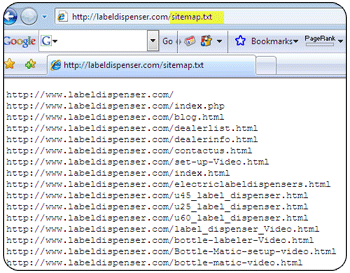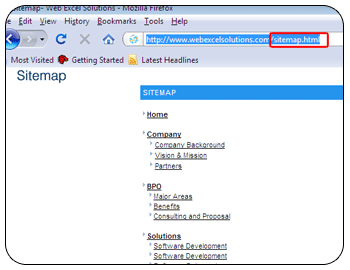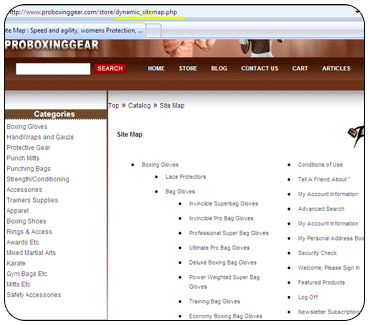Importance of Sitemaps
Sitemaps, simply stated, are just a map of your site – a page that displays the structure of your site, its various sections, the links between them, etc. Sitemaps are primarily intended to provide visitors with all kinds of navigational help they will require. Sitemaps are an extended form of navigational aid wherein you display the web site structure with links to major sections and sub-sections. As a matter of fact, sitemaps are considered an important way of communication with search engines. Thus, web developers provide sitemaps not only for easy navigation by visitors but also
See the diagram below for a sample of a site map structure:
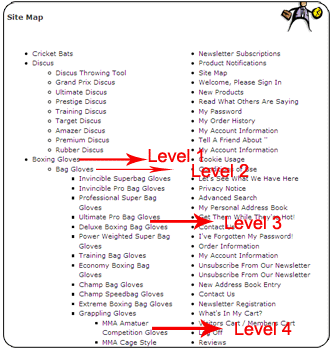
for greater visibility by search engines. It is the aim of a web developer to get all public pages on your web site in the search engine database. Since a site map carries links to all pages from one page, it is the best way to submit to search engines.(Google Sitemap Submission & Bing Sitemap Submission) Submission of the site map to a search engine might help in getting all web pages indexed quickly by the search engine. Depending on the size of the website, the sitemap may actually link to all of web pages. This means that once the robot finds the sitemap page, it can visit each and every page on your entire website.
One might ask why sitemaps are necessary. People consider a site map as indispensable is because it helps visitors to understand the site structure and layout and thus enables, quickly access to what your site has to offer. The visitor can then choose the page to which they want to go with just one click. The other need is for spiders mainly for Googlebot- though others may soon join the fray. It is pertinent to note that Google in its Webmaster Guidelines recommends that sites should have a sitemap.
There are different types of Sitemaps used for different purposes:
Text sitemap - TXT file
HTML sitemap - HTML file
XML sitemap - XML file
PHP sitemap - PHP file
Sitemap helps visitors to find inner pages of your website. For such usage one uses the HTML or PHP sitemap. Professionals recommend using two or three different formats of sitemaps concurrently on the website. For normal visitors an HTML or PHP sitemap is necessary. Google accepts sitemaps in XML format. Since Yahoo and MSN accept sitemaps in TEXT format, you may simply add all the URLs under your website in a text file and save it as sitemap.txt.
Sitemaps are used to inform search engines immediately about any changes in the structure of your site. Of course, it is not to be expected that search engines will hurriedly index your changed pages but certainly the changes will be indexed faster than if you did not have a sitemap.
Although using a sitemap itself is no guarantee of improved site rankings, it does however provide a website a better opportunity of getting listed on a search engine. Sitemap techniques can be used to place the website high in the search engine positions. Regular monitoring and doing necessary adjustments of the Sitemaps would ensure that a website is kept near the top ranking to attract continued traffic.Here are some guidelines for creating an effective site map, which will help visitors to instantly find information on your web site:
The site map should be absolutely simple and user-friendly on your web site. Any complicated sitemap will maske visitors turn away.
Do not offer any fancy name as that will confuse visitors. Name it merely as Site map, so that your visitors understand immediately what you mean.
Dynamic site maps are to be scrpulously avoided as that would mean the visitors will have tough time navigating to get hold of information. Remember, the reason visitors comes to a site map page is because they want quick and easy guidance.
It may be worthwhile to write a sentence or two describing the page contents below the link for that page.
To make your sitemap appealing to the search engine robots and visitors it is advisable to include meaningful text along with the page URLs and links. Use keywords including appropriate content for each of the pages to which you link.
Creating a number of properly interlinked web pages within a website would indicate to the search engine that the information architecture of the site is reliable and this could translate into Top ranking in search engine.
It is recommended that you provide a pathway to facilitate the search engine robots to follow in order to reach your most important web pages.
A link to the site map page is necessary and all pages should carry this link. The site map link can be included with other links in the main menu or prominently situated at a section on the web page.
One more important thing to remember – the color for visited links should be different from that of non-visited links so that visitors will be able to discern which pages they have already seen and avoid duplication.
Sitemaps need not always be a series of links presented in tabular format. You can also provide details for each section and sub-section through descriptive text. Although sitemaps were commonly found on many sites, sitemaps have suddenly gained in importance due to adoption of sitemaps by search engines. However, if you are interested in sitemaps as a SEO necessity, you cannot be content with the conventional sitemaps.
Though Yahoo! and MSN still recognize the standard html format, Google Sitemaps uses a special XML format. The worst form of sitemaps are those that do not provide links. It is purposeless making a sitemap without links and therefore remember to provide correct links and keep the sitemap updated at all times.
A website that is completely indexed has better chances of getting to the top of search engines. As the site’s main page and other content are directly linked to a site map, crawlers can easily travel through the website, identify the keywords of the content and index them. Writing code for SEO sitemaps is quite easy and simple to format and maintain.
There are two known ways to generate a sitemap. You can either download and install a sitemap generator or use an online sitemap generation tool (Here you can generate pages upto 500). Although the first method is certainly difficult, you have better control over the output. The second method is much easier. There are many free online tools available to do the job. You can look at the list of third party sitemap tools. You will find this list will helpful because you will be able to identify exactly what you need.
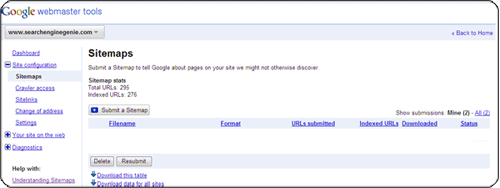
After you have created the sitemap, you need to upload it to your site and notify Google about it. Notifying Google means adding the site to your Google sitemaps account. As of now, Yahoo! and MSN do not support sitemaps in the XML format, used by Google. Yahoo allows webmasters to submit “a text file with a list of URLs” (which is a broken down version of a site map) while MSN, it is rumored, is indexing sitemaps when they are available onsite. It is however very likely that both Yahoo! and MSN follow the Google way because user-submitted sitemaps are powerful SEO tools.
For more Search Engine Genie Articles
You may contact us for further details by clicking here or e-mail us at - support@searchenginegenie.com





